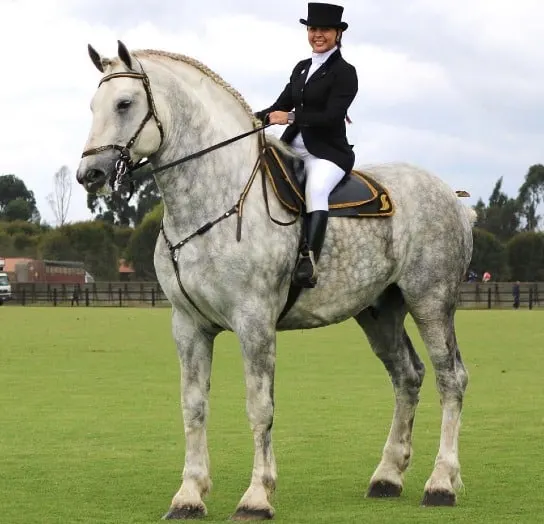If you weigh 250 lbs or more, you can still enjoy horseback riding as long as you ride the right horse. The safety of the horse and rider should always be the priority, so it is important to find the right horse breed that can heavy riders.
Disclaimer: Please note, we are not offering medical or veterinary advice. Always check with your vet before riding if it is safe for you to ride your horse.
Finding the Right Horse Breed for Heavy Riders
When horseback riding, the rule of thumb is that a horse can safely carry 20% of its body weight.
So, if you weigh 250 pounds, you should aim to ride a horse that weighs 1,250 pounds or more. This will help ensure the horse’s safety and ability to work.
Balance is also a key aspect of how much weight a horse can carry. A horse will have an easier time supporting a fit and balanced rider, as an uncoordinated rider can throw off a horse’s balance and cause fatigue.
If you are ever concerned about whether or not your horse can safely support you, consult a veterinarian for advice.
8 Best Horse Breeds for Heavy Riders
Larger breeds are often the best option for riders who weigh more than 250 lbs. A horse doesn’t necessarily have to be taller, but they should have a sturdy build.
Horses with a stockier build will be capable of carrying more weight than refined, lean breeds. The circumference of the cannon bone is often a factor in how sturdy a horse is.
Horses that have larger cannon bones can often support more weight, as it is a weight-bearing bone.
Clydesdale

Standing between 16-18 hands, Clydesdales make great riding companions for larger riders. In fact, they are even becoming popular riding horses for show and pleasure. Their stocky builds and kind temperaments make them safe for riders of all types.
With the average Clydesdale weighing between 1,600-1,800 pounds, they can carry around 320 pounds. That is equivalent to around a 280 pound rider with a saddle that weighs about 40 pounds.
Though they are well known for being driving horses, Clydesdales can also make wonderful riding horses. This cold-blooded horse breed is very gentle and has friendly dispositions that make them reliable riding mounts.
Shire

One of the largest breeds of horses, Shires are powerful and calm. Though they are not typically thought of as riding mounts, they can make incredible companions in the saddle.
With the average Shire weighing between 1,700-2,000 pounds, they can carry around 340 pounds. That is equivalent to around a 300 pound rider with a saddle that weighs about 40 pounds.
Despite their large size, they are rather athletic, which makes them great mounts for active riders. We also featured Shires in our guide to the best horse breeds for novice riders.
Friesian

Elegant, graceful, and powerful, the Friesian makes an excellent riding partner. They are known for their animated gaits, beautiful carriage, long hair, and feathered hooves.
A Friesian will typically stand around 15-17 hands. For a Friesian to safely carry a rider weighing 250 pounds with a saddle that weighs about 20 pounds, the Friesian needs to weigh about 1,360 pounds.
They are well known for their versatility, as they are often shown in saddle seat, hunt seat, western, dressage, and driving divisions.
These beautiful black horses stand out for their stunning flowy manes and tails and luxurious feathers. Also, please read our article 8 things you didn’t know about the Friesian horse breed.
Irish Draught

Irish Draughts generally stand between 15-17 hands and typically weigh between 1,300-1,400 pounds.
For an Irish Draught to safely carry a heavy rider weighing over 250 pounds with a saddle that weighs about 20 pounds, the Irish Draught needs to weigh at least 1,360 pounds.
Their strong builds combined with their athletic nature make them great partners for all types of riders, whether petite or larger builds. They often excel in dressage and jumping, making lovely show or pleasure horses.
Easy-going and hardy, the Irish Draught makes a lovely riding companion. They are well known for their sensible attitudes and great stamina. To learn horse about this breed, read our Irish Draught breed profile guide here.
Percheron

Photo Credit: Criadero Sumatambo
The Percheron breed is famed for its power and strong work ethic. These gentle giants are most commonly used for driving and farmwork, but some can also make wonderful saddle horses.
With the average weight of a Percheron being between 1,800-2,000 pounds, they can carry around 360 pounds. That is equivalent to around a 320 pound rider and a saddle that weighs about 40 pounds.
These big horses have calm and friendly dispositions, making them reliable to work with.
Though they might not be typically thought of as riding horses, many heavy riders have found them to make trusty mounts.
Spotted Draft Horse

Weighing between 1,500-1,600 pounds and standing at 16-17 hands, an average American Cream Draft can carry up to 300 pounds. This is equivalent to around a 260 pound rider and tack that weighs up to 40 pounds.
Though they may not be a common breed, the Spotted Draft Horse has made a name for itself as a wonderful riding mount. These lovely drafts stand out due to their beautiful coat patterns.
Spotted Drafts are docile and willing to please, and more agile than other popular draft breeds. This makes them a great breed for larger riders who want scope for more than just casual riding.
Cleveland Bay

Large, powerful, and elegant, the Cleveland Bay makes a wonderful riding mount. They are known for their beauty, stamina, and sensible temperaments, making them great horses for all ages.
Typically stand between 16-16.2 hands and weighing around 1,400-1,500 pounds, Cleveland Bay horses can carry around 280 pounds. That is equivalent to around a 260 pound person with a saddle that weighs up to 20 pounds.
These beautiful horses must be bay, with black points and the only white that is permitted is a star marking.
They are the oldest horse breed in Britain and are well-loved for their sturdy yet athletic builds.
American Cream Draft

Though the American Cream Draft is not a common breed of horse, they have a strong fan base. These beautiful horses, known for their cream coats, are the only draft breed native to America.
The American Cream Draft stands around 15.1-16.3 hands and typically weighs between 1,600-1,800 pounds. They can carry around a rider up to 320 pounds (including 40 lbs of tack).
Their unique coats range anywhere from pale cream to a rich golden, and they are known for their signature amber eye color. They have strong yet graceful builds and are often used for riding and driving thanks to their good dispositions.
Frequently Asked Questions Does Riding Damage a Horse’s Back?
If horses have well-fitting tack and a well-balanced rider that does not weigh over 20% of their body weight, riding should not damage their back. Most horses will have no back problems from riding as long as these protocols are followed.
What Kind of Horse Can Carry a Heavy Rider?
A strong, well-muscled horse with sturdy legs larger in size can often carry a heavy rider. Though the typical rule is a horse can carry 20% of its body weight, some horses can carry more.
Can a Horse Carry 300 Pounds?
Some large horse breeds that weigh 1,500 pounds or more can be capable of carrying 300 pounds. However, always ask your vet for advice before riding!
Is There a Weight Limit for Riding Horses?
Though there is no set weight limit, few horses can safely carry more than 300 pounds. Some riding facilities will set weight limits to ensure the safety of the horses and riders. The weight limit can range from 210-300 pounds depending on the facility and their available horses.
How Do You Know If You’re Too Big For a Horse?
Typically, your weight should not be more than 20% of a horse’s weight. If a horse struggles to carry you, is sore after your ride, and is showing signs of discomfort, you are likely too big for that horse.
Disclaimer: Please note, we are not offering medical or veterinary advice. Always check with a vet before riding if it is safe for you to ride your horse.
Also read:
How Much Can a Horse Carry?Horse Breeds Height & Weight ChartHow Much Does a Horse Weigh?Shire Vs Clydesdale Differences
Source: horseyhooves.com








